China Food Industry: Opportunities for Foreign Producers
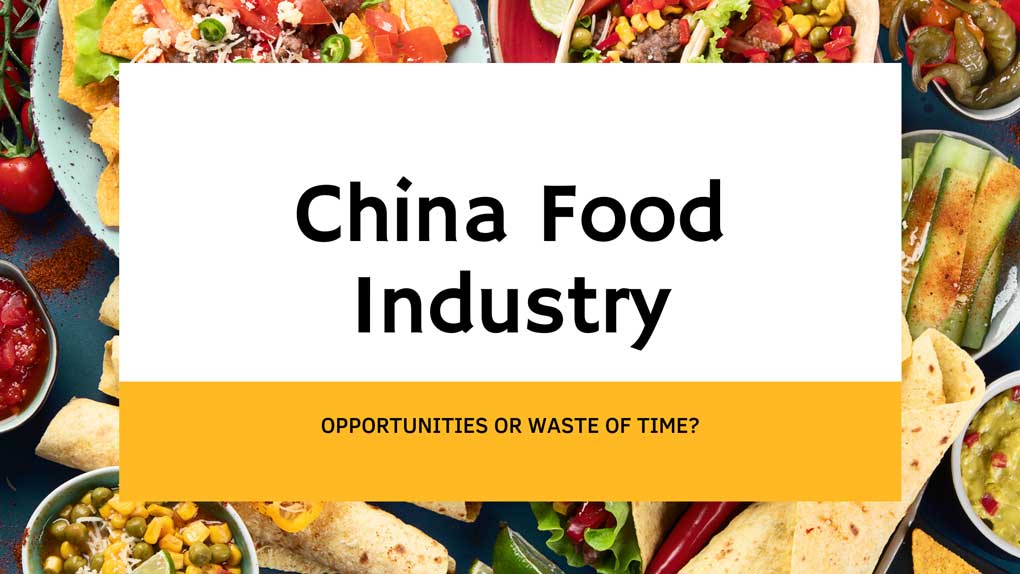
China food industry is booming, and foreign producers are taking notice. Opportunities abound in the burgeoning market for everything from processed foods to restaurant chains. If you’re looking to break into the China market, here’s what you need to know.
What are the trends in the Chinese food industry? What kinds of products are popular? How can foreign producers tap into the market? This article will answer these questions and more so that you can make the most of this growing sector. Read on to learn more!
Cost-Effective Agency
KPI and Results focused. We are the most visible Marketing Agency for China. Not because of huge spending but because of our SMART Strategies. Let us help you with: E-Commerce, Search Engine Optimization, Advertising, Weibo, WeChat, WeChat Store & PR.
How Big is China Food Industry?
As the second-largest economy and the most populous nation globally, it’s no wonder that China has a sizable food market. In 2022 alone, the Chinese food industry was worth $1.3 trillion, and the most considerable bulk being consumed was bread and cereals.
Like many sectors, the China food industry is undergoing increased digitalization. In fact, China has seen a development in online purchases from 11.5% in 2017 to a whopping 36.5% of total food consumption in 2022.
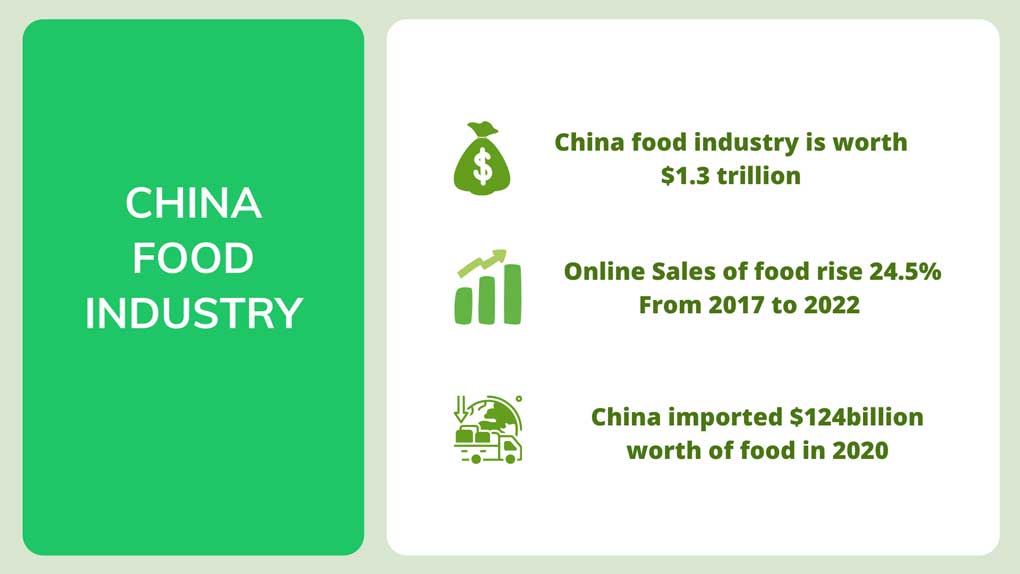
With this data, China has finally overtaken the U.S. as the world’s largest food and beverages market. As China’s food market steadily increases, domestic food production and import are ramping up in volume and value. Despite the growth, though, China is no stranger to an array of issues such as fake food scandals.
China: Is It an Agricultural Nation?
China remains a predominantly agricultural nation despite the rise of Chinese food plants, Chinese food processing, and manufacturing. In fact, agriculture is one of the most remarkable feats of the Chinese government. According to the Food and Agriculture Organization of the United Nations, they can feed one-fifth of the world’s population and produce one-fourth of the world’s grain with only one-tenth of the world’s agricultural land. This achievement was made possible because of the high priority placed by the Chinese government on its agricultural sector. In recent years, China decided to shift its spending priorities from ramping up agricultural and domestic food production to rural income support and more environmental sustainability.
This shift in policy is primarily seen to address the growing disparity of incomes between urban and rural populations. For instance, the more significant production in rural areas gave rise to a surplus of farm labor which yielded low agricultural incomes and hidden unemployment.
Currently, China still has over 200 million households focused on farming which primarily reside in rural areas of the nation. These farm households generate labor-intensive crops such as:
- Fruits
- Vegetables
With a total support estimate (TSE) of 3.7% of China’s GDP, China is still a predominantly agricultural nation due to its demand for grains and other crops.
China food industry: Success of Imported F&B Goods
With an increase in the disposable income of a typical Chinese consumer, food imports have also increased. In addition, Chinese consumers now have a higher awareness of food safety, which led companies to push for lower sugar in their products and the integration of healthier ingredients.
Demands for the following products are projected to increase in the next years:
- Meat and dairy
- Animal-sourced calories
- Pig and Poultry
- Oil crops
- Cereals
- Soybean
Increased domestic food production will partly address the demand for these products. For instance, 33% of domestic food production will be dedicated to pig and poultry products. However, there will also be an increase in food imports to augment domestic food production. From 2013 to 2017, China’s food imports increased from $14 billion in value to a whopping $104.6 billion.
Increasing Food Security Through Imports
While food shortages have been happening in parts of China for quite some time, the issue has been exacerbated by the COVID-19 pandemic. Lockdowns like those in Shanghai are threatening the nation’s food supply. This is on top of a minimal arable land that is feared to be unsustainable in the face of a rapidly growing economy. As a result, China is heavily reliant on other countries for food imports. To demonstrate, China is the world’s largest soybean importer.
In the past, the U.S. had been the primary nation from which China had been importing soybeans worth $13.9 billion. However, their ongoing trade war significantly reduced this value by almost half (or only $7.1 billion). While they turned to Brazil as an alternative for soybean imports, their appetite for the crop couldn’t be satisfied by other producers, making the U.S. a critical food partner for the Chinese.
Key Trends in the China Food Industry
China’s food industry is ever-evolving. Characterized by dynamic domestic policies, industry issues like fake food and the growing concern for sustainable food consumption, China’s food industry developments are exciting and present an opportunity for food producers abroad.
Here are the key trends and food news that you need to watch out for in China’s food industry:
Present and Future Food Demand for Organics
The China food industry has experienced several setbacks in the past few years. Due to the increased demand to produce food in China, several food producers resorted to illegal means to sell and make a profit. These schemes resulted in numerous blunders and counterfeit food scandals that still haunt a typical Chinese consumer up until this day.
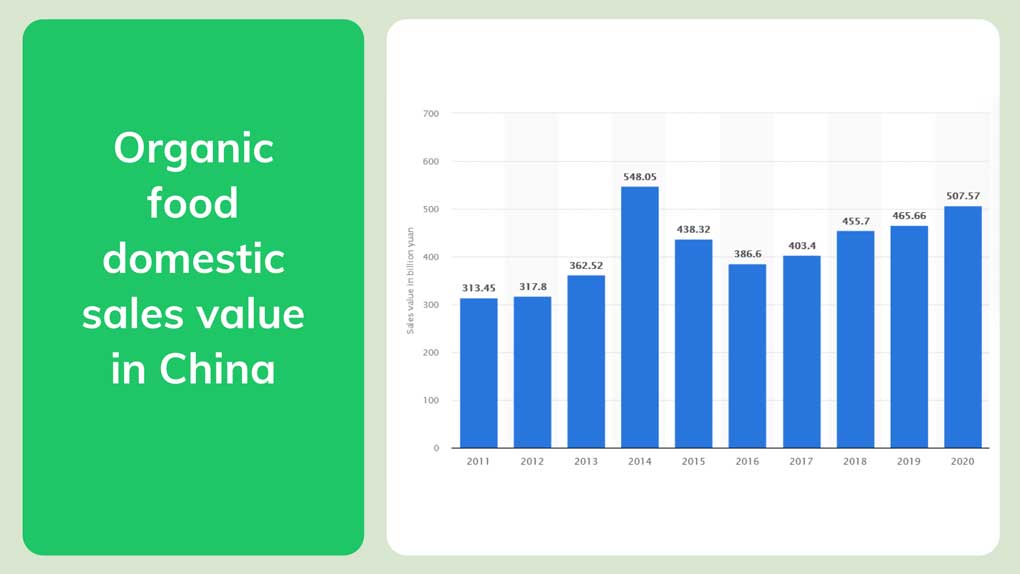
Food scandals such as mislabeled fish, horsemeat, and extra-virgin oils are just some of the most well-known Chinese food blunders.
Budget milk brand Sanlu is perhaps one of the biggest food scandals that China has ever had with its melamine-adulterated milk. Their milk killed six infants and hospitalized around 50,000 Chinese citizens. This food scandal ultimately led to the milk brand’s demise.
As a response, China’s consumers are now more demanding. For instance, they’ll generally prefer buying healthy food. These foods are either those with low sugar or healthier alternatives as ingredients.
Organic food and other products accredited by the U.S. Food and Drugs Administration sell better in Chinese markets. This is especially true since there’s a genuine concern for fake food in China.
If you’re an organic food producer, then China’s emerging healthy food sector can be a viable expansion area for your business. This also comes with the rising trend of a more health-conscious mindset all around the globe, where an average consumer is more likely to read the nutritional values of their food products. These food scandals are a perfect opportunity for organic, vegan, and other healthy food sellers to grow in China.
China’s food Industry and E-Commerce are walking hand in hand
Online shopping is also thriving in the China food industry. Many Chinese retailers and even foreign food brands use eCommerce platforms to sell their products. Some examples of this growing practice include:
- Using e-menus
- Ordering through mobile phones
- Online food reservations and delivery
- Online payments
The rise of eCommerce for Chinese food is partly because of virus-led lockdowns in cities where consumers can’t get out of their homes. As a result, new food eCommerce and online grocery platforms have popped up in China. For instance, Chinese eCommerce giants such as JD.com and Alibaba’s TMall are now offering options to buy groceries straight from their homes. Newer eCommerce platforms such as Pinduoduo specifically target Chinese consumers in rural areas that are more price-sensitive than those in Tier 1 cities.
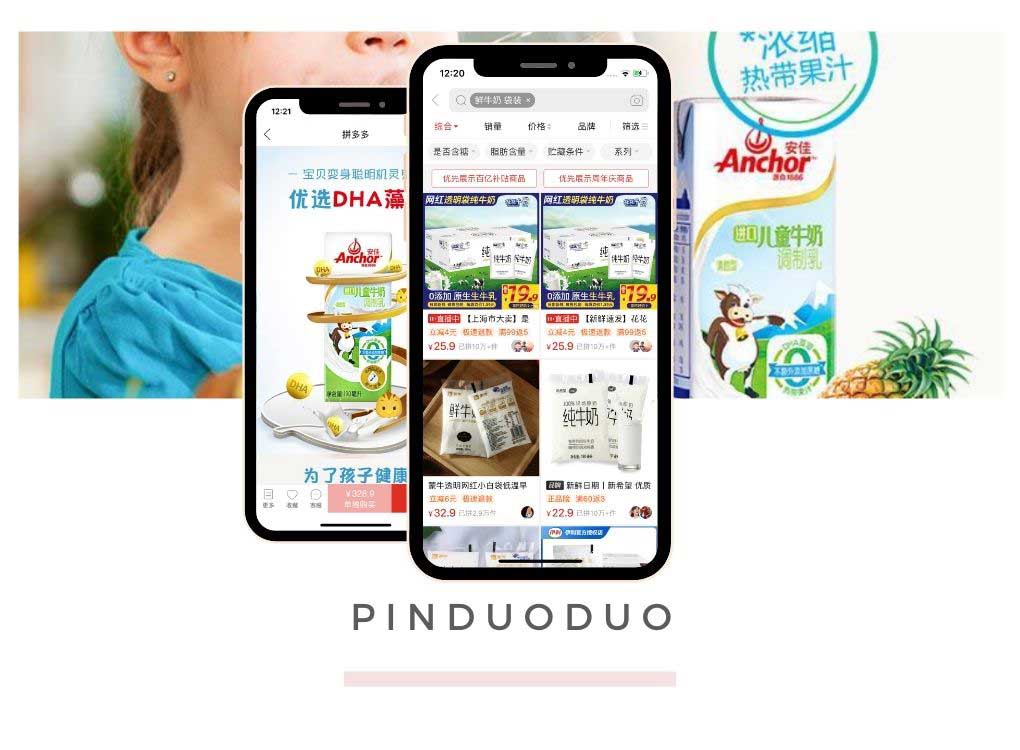
Foreign producers have an array of options for eCommerce platforms which depend on their target demographics and the elasticities of food products. For instance, JD.com and TMall are the preferred platforms in Tier 1 cities for food consumption. You need to carefully select your eCommerce platform to succeed as a foreign producer in online shopping.
McDonald’s is one good example of a foreign food retailer that successfully leveraged digital selling. The American food giant used mobile order-and-pay systems in some of its Chinese branches for its more tech-savvy customers in China.
Ecommerce is a great alternative to distribution for brands and producers in China.
Rise of Coffee Culture
While China is primarily seen as a tea-drinking nation, coffee as a beverage has risen in popularity in recent years. The rise of coffee in China came with the opening of the first Starbucks branch in Shanghai in 1999. Furthermore, the income of a typical Chinese consumer grew, and the influx of westernized Chinese has led to the increased demand for coffee in China. Seen as a status symbol, especially for the younger generation, coffee culture presents an opportunity for coffee retailers and brewers to expand in China.
However, multinational coffee brand Starbucks currently dominates the China food industry for coffee. On the other hand, small international brands and homegrown brands like Luckin Coffee are holding the last few percentages in the Chinese coffee market.
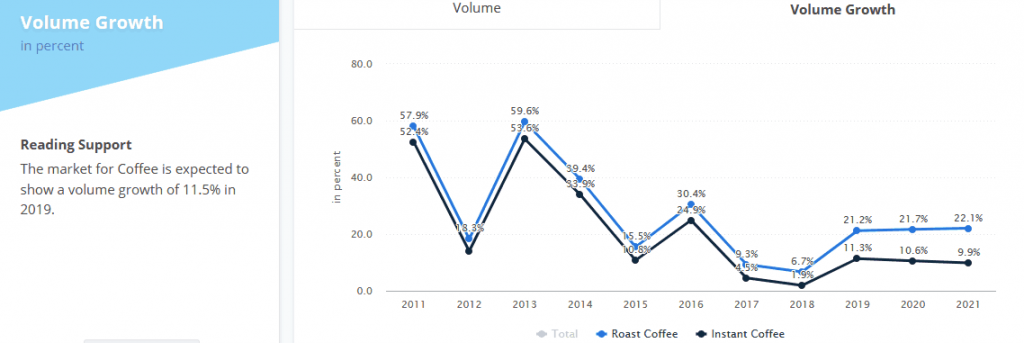
Since coffee shops function as a status symbol and places to socialize, many coffee chains have started to sprout all over the nation. While the competition in the coffee segment is fierce, it’s no doubt that the food demand for coffee in China will continue to grow in the following years. The main development areas in this food segment are the youth, millennials, and businesspeople. So, suppose you’re planning to delve into the Chinese coffee industry. In that case, it’s wise to keep these demographics central to your strategy.
Personalized Food Menus
Since opening its market to international brands and tourists, China has adopted some changes in its menus in the foodservice sector. Most notably, many restaurants all over China are now offering customized menus for different customer demographics. For example, coffee shops like Starbucks give their customers an option for low-sugar coffee. Likewise, McDonald’s also opened “create your taste” outlets all over China which are designed to provide quicker customer service. These outlets will give their customers the option of their type of bread, toppings, condiments, and even the number of patties in their burger.
Personalized menus give a higher level of involvement for a Chinese consumer, which is excellent for improving the customer experience. This is definitely a great way to touch as many customer demographics as possible. However, personalized menus also require excellent logistics and preparation systems to meet the different demands of your customers.
China’s New Import Law
While there are numerous opportunities to import food products to China, it’s necessary to check its current import law, which may become a barrier for foreign producers.
Their revamped import law has updated the foreign brand registration process with the General Administration of Customs of P.R. China (GACC). This import law also updated the labeling requirements for imported products which means that importing to China can become more complex.
Decree 248 requires all export food and drink products to register their manufacturers, processors, and storage companies with the GACC. These products include:
- Meat and aquatics
- Coffee beans
- Cereals
- Dairy
- Nuts and seeds
On the other hand, Decree 249 will require food producers to indicate the following information on their food labels:
- Country/Region of origin
- Product name
- Manufacturer registration number
- Production batch number
There are also additional requirements for meat and seafood. Meat products also need to indicate:
- Destination
- Date of production
- Shelf life
- Storage temperature for the outer packaging
Seafood will also need to disclose the following in its labels:
- Shelf life
- Destination
- Transportation, catching, and processing vessels
- Storage condition
Not following these new import requirements will subject your company to penalties and even suspension based on the severity of the violation.
China Food Industry: to conclude
The food industry in China is growing rapidly and offers a number of opportunities for businesses. Some of the challenges that companies face include complying with government regulations, sourcing ingredients, and ensuring food safety. However, the potential market in China is huge, and there are many ways to succeed in the industry if companies can overcome these challenges.

As a food brand, if you want to tap into the lucrative Chinese market, it’s important to have a reliable and experienced agency on your side. At our company, we have over 800 successful food brands under our belt and years of experience navigating the complex Chinese landscape.
We understand the ins and outs of doing business in China, and we can help you successfully export your product to this growing economy. Contact us today for more information about our solution – we look forward to helping you grow your business!

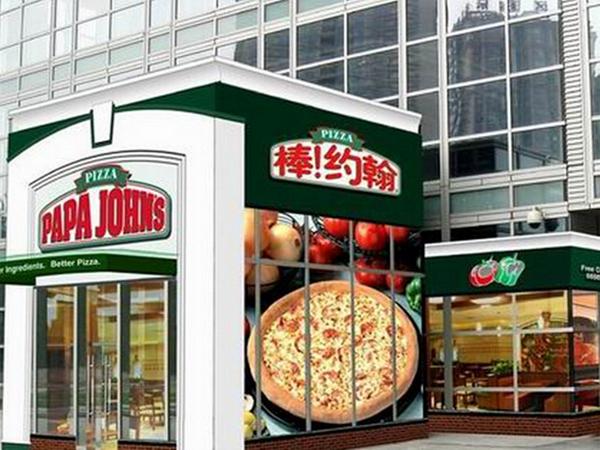


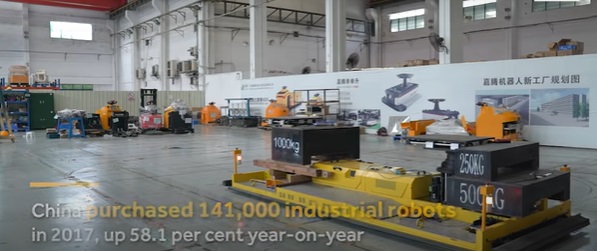


BEEF
We Export Worldwide
We are Authorised Exporters and our Company is Approved SIF.
Our Minimum Order Requirement is 5x20ft containers.
how can you help us ?
Hello,
I represent China Jiaxiang Group a Chinese Importer and we want to partnership with foreign Snacks brands and alcoholic brands with exclusive agreement.
Send me your message and give me your WeChat
Very interesting conversation on Linkedin About Food & Agriculture in China
https://www.linkedin.com/posts/olivierverot_china-agriculture-food-activity-7071807698178056192-iNiR